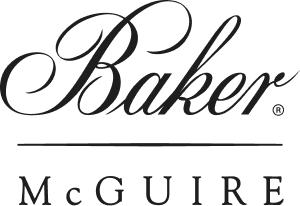Baker/McGuire craftsmen have spent hundreds of hours creating this fine piece of furniture. Wood is a natural material with variations of color shade, configuration, streaks, and grain structure. Just as trees in the forest are not the same, each individual piece of Baker/McGuire furniture has characteristics markings that will differ from photo and showroom samples.
Careful housekeepers of the Eighteenth Century followed Thomas Sheraton’s advice: “Melt some beeswax and, when ‘tis cold, make it up into a ball and rub it over with a polishing brush; labour it ‘til the luster be to your liking.” It is this “labour” that is responsible for much of the delightful patina to fine old pieces.
Sheraton offered this advice because he knew that the finest furniture in the world will deteriorate with neglect. His advice is as good today as it was then. Do not be afraid to use on your Baker/McGuire furniture, that is what is is for! When you place fine furniture into your home or office, give it the care it deserves. Careful and regular waxing is the most important element in the care of fine furniture. Each time you wax a fine surface you improve its effect and preserve the life of the piece. This is the best protection from permanent damage to a lacquer finish.
Other Tips to Help Preserve Your Fine Furniture Investment
Spills should be blotted immediately rather than wiped. If water stands on the surface there is the possibility that it will cause white marks in the lacquer finish. You can remove these blemishes by heating the area with a hair dryer and applying Endust while the surface is still warm. Follow by buffing with a soft cloth and re-apply paste wax if needed. If perfume or nail polish remover is spilled, do not wipe or blot it. The lacquer that has been softened by the chemicals should return to normal when the liquid has evaporated. Allow the area to dry, rub it with a fine automotive polishing compound, and apply a fresh coat of wax. If candle wax drops on your wood finished surface, hold an ice cube to the wax to harden it. Blot up the water, and use a dull plastic spatula to remove the wax without touching the wood. Gently scrape away any remaining wax, and rub the area with furniture wax to replace the protective coating.
Wood is a natural product. Sun bleaching will occur when wood furniture is exposed to sunlight. This will cause darker finishes to lighten and sometimes cause lighter finishes to darken. For this reason, try to avoid placing furniture in direct sunlight and rearrange accessories from time to time to prevent spot bleaching. Some bleaching will occur under both incandescent and fluorescent lighting. Arrange your furniture so that it does not sit near heat registers, air-conditionings units or radiators. It is important to keep the home or office in which your furniture is placed properly humidified. Lack of humidity, usually in the winter months or in dry climates, can cause certain veneers to crack or check, and joint to work.
Some plastic feet on computers, calculators, telephones and other rubber or plastic products, such as placemats, and vinyl notebook binders etc. contain a plasticizing agent that may discolor or soften the lacquer finish on fine furniture. Always use felt pads under these articles to prevent discoloration or softening of the lacquer. Articles such as glasses, bookends, flowerpots, and hot cups and dishes should have cloth or felt type pads on them. Beware of some felt pads that have a pre-glued side as some of these adhesives contain chemicals that can damage the lacquer. Always remember to lift objects rather than sliding them across the finish.
Arrange your furniture so that it does not sit near heat registers, any direct heat source or direct sunlight. Remember, even the finest furniture will deteriorate with neglect. Remember, when you put the fine furniture into your home or office, give it the care it deserves to preserve the life of the piece for generations to enjoy.



